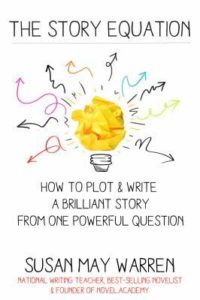By Susan May Warren
- No STAKES! Your character must have something at STAKE that makes the reader care and want to read more. Authors often start with backstory or creating the storyworld instead of getting to the character’s immediate problem, creating a sympathetic situation where we see him interacting with his world, setting him up for the inciting incident (or even in the middle or after it), and making us CARE.
Your character must have something to lose, or we won’t care if he wins the day or not. This is why people don’t want preseason football or the Pro Bowl. There is nothing at stake. Insert this risk/fear of losing into your scene/chapter/book and you will have created a compelling element to your story.
Remember, the first three chapters of your novel are the “drive” chapters, the chapters that propel your reader into the story. Make us care about your character in the first scene.
Book Therapy Fix: Ask, “What does my character have to lose in this scene/chapter/book? What will happen if he/she doesn’t accomplish the goal?”
- Short Scenes. At the beginning of a book, it is essential to build that storyworld and characterization, as well as establish the stakes. . . . It’s nearly impossible to do this with a short scene. We need to get into the story, wade around, see the parts, and get deep enough to be taken by the current. Aim for at least 1,200 words.
Book Therapy Fix: Ask, “Is my scene an Action scene or a Reaction scene?” After determining what kind of scene it is, make sure you have all three components built into your scene.
Action = Goal + Conflict + Disaster (or new problem)
Reaction = Reaction + Dilemma + Decision (or new goal)
After you have established these three goals, then make sure you have added
Storyworld – including the five senses!
Dialogue – Are you putting the story between the quotes?
Conflict – Is there enough conflict?
- No Scene-Ending HOOK. In other words: not ending the chapter in a place that makes the reader want to read more. Don’t resolve the tension! Or, if you do, raise a new problem. If you resolve the tension, the reader won’t want to read more! Keep the tension going or introduce new tension and your reader will turn the page.
Book Therapy Fix: Create new dilemmas at the end of your chapter by answering one or more of these questions.
- What is the worst thing, externally (circumstance, or physically?), that could happen to my character?
- What is my character’s worst fear at the moment?
- What is the worst information my character can receive right now?
- What is the worst trouble my character can get into in this scene? Raise the stakes so the character is further from his/her overall goals.
- Have I set up the danger for the readers before the scene begins? (unexpected yet plausible?)
- Have I made my readers CARE about my character? Can they sympathize? (Spell out the stakes often enough so the reader worries!)
- Unrelatable Motivation. Have you ever wanted to throw a book against a wall because the main character does something completely out of character, without a good reason? This happens when the author must compel the character to act in order to stay on plot course. It makes the story—and the character—unbelievable. But this can be easily fixed by not only understanding your character’s values and motivations but by showing your character’s choices as the character moves forward through the plot. Consider why the character is driven by a deep need, an inescapable value, or a piece of his/her greatest dream/compelling reward.
Book Therapy Fix: Create a “Push/Pull” for every scene. Every scene has to have an emotional or physical push/pull (or combination thereof). It’s the PUSH away from something negative and the PULL toward something positive.
- Tired Writing. This includes clichés, passive writing, mundane dialogue, and, most of all, bad writing. Like mixed metaphors (when in doubt, don’t use a metaphor!) or soap-opera emotions. “His heart banged inside him like a parade of marching band cadets” is NOT good emotional writing. Neither is “Panic bombarded her like an avalanche of snow.” Don’t give us the expected, clichéd emotions—go deeper to create an emotion that feels real. Most of all, show it through their actions, dialogue, inner thought, and even the setting.
Book Therapy Fix: Ask yourself, “What is your character feeling right now (as the scene opens)? When have you felt this way? How did you act/feel/speak?” Pull from your experiences to create realistic emotions.
Try these fixes to create powerful stories!
Susan will be mentoring and teaching a seven-hour intensive coaching class, “A Novel Career: for both indie and traditional authors at every stage in the writing journey,” at the 2017 Oregon Christian Writers Summer Conference August 15–18 in Portland.
Susan May Warren is owner of Novel Rocket and the founder of Novel.Academy. A USA Today best-selling author of more than 50 novels with Tyndale, Barbour, Steeple Hill, Summerside Press, and Revell, she’s an eight-time Christy Award finalist, a three-time RITA finalist, and a multi-winner of the Inspirational Readers Choice Award and the ACFW Carol Award. A popular writing teacher at conferences around the nation, she’s also the author of the popular writing method The Story Equation. A full listing of her titles, reviews, and awards can be found at: www.susanmaywarren.com. Visit www.learnhowtowriteanovel.com for more tips on writing a brilliant story!










